A part of our democratic work with young children as educators and parents is that scary bit of allowing children to learn through mistakes.
Of course, I am not advocating for children to make dangerous mistakes - it is our adult responsibility to hold the play and learning space so that it is safe as necessary. This means that the hurts they get - physical and emotional will not lead to long term negative effects on the lives of the children. We need to discern between the mistakes that will serve them well and the mistakes that either serve no purpose or are dangerous. For instance having a mat that causes numerous children to trip frequently, even if they never hurt themselves - is not something we learn from, it is something that get’s in the way of learning - so either removing the mat, or fixing the bit that sticks up and routinely trips people is necessary - a mat that one or two children accidentally trip over once is teaching them about the floor being uneven and the need to adapt their bodies when moving.
Sometimes, in their play, children will get bumps, bruises, scratches and grazes - small injuries that heal quickly, with not too much pain - but can offer lots of learning (about the limits of our own body, the limits or fickleness of the materials around us etc). When I was a child there was a phase of my life when my friends and I always had a bruise or some ouchy mark that had a story of play behind it. We often compared them. One of my roles at school that I took on myself, was to take those that had fallen over and grazed their knee inside to treat with a wet paper towel - seldom were teachers involved unless there was a lot of blood or a more serious injury (we always had to check in with a teacher before going inside - so I guess this is when the adult was doing their risk assessment - can the children manage this by themselves or do they need help).
it was an almost daily occurrence - definitely weekly.
This does not happen this scale these days I find. is it because
children do not play as intensively
children have less time to play therefore there is less opportunity to have an accident
children’s play is more controlled and therefore the play is “too safe”
children play it safe and are afraid of hurting themselves - picking up fears from adults
a mix of all of the above plus other reasons?
At this time of year in Sweden the winter overalls come off and it’s interesting to watch the play of children - those who had been relying on their clothes to buffer their deliberate falls and crashes, or accidental ones while pushing the limits of their body - suddenly discover that skin (or thin clothing) against the hard ground is not comfortable - and within a day they have adjusted the way the play. But it took falling, getting a bruise or a graze to fully understand this, and to know how far they can push themselves in their play.
A democratic play and learning space includes allowing children to test where their personal limits are… for some this will not look risky at all, yet it will be for them, while for others they will maybe need to go beyond what feels risky to the onlooker to find the edge of their personal capacity.
This is why it becomes a democratic practice…
Care and compassion. Taking care of yourself and others - in risky play they learn how to take care of themselves by understanding their own capabilities and limits. They also learn how to take care of others when they hurt themselves physically in play. Cognitively, socially and emotionally we have capabilities and limits too - and this we learn through mistake making as well. And in the same way as adults we need to be able to discern between mistakes that will help them learn how to communicate care and compassion, and how to receive it, from mistakes that will have more lasting affects.
Freedom. Enjoying your rights and privileges without negatively impacting the rights of others. This is vital - freedom to make mistakes without negative judgement, freedom to challenge our personal limits, freedom from over controlled and too safe environments.
Respect. Treating others with consideration/respecting another’s perspective. In risky play (physical, social, emotional and cognitive) we need to respect our own limits and abilities as well as respect that others will differ from us - that someone is not lesser because they do not dare - because maybe they are already daring much more than you know.
Responsibility. Taking responsibility for own actions. Rights always come with responsibilities. Becoming aware of how our own actions impact others both positively and negatively. Social-emotional bruises and grazes are harder to notice - children will inflict these on others (as well as minor physical injuries) as they learn how to self regulate and take responsibility over their actions and words.
Understanding, acceptance and inclusion. Being aware of others and their cultures, accepting diversity within a democratic society, to be included and including. Learning to be kind will be fraught with mistakes - being democratic is creating safe and brave spaces for children to learn these skills (see belonging)
Influence. To be listened to and to listen to others. Risky play is most definitely connected to influence - bumps and bruises will happen as children learn how to influence and be influenced as part of a community.
Participation. Everyone has the right to participate in their own way. This will mean that children who need more of a challenge have just as much as a right as children who play within the adults personal sense of risk.
Belonging. Creating an atmosphere where everyone can feel a sense of belonging. Creating a sense of bumps, bruises and grazes belong to the quintessential childhood experience, and that some children might get more than others for a variety of different reasons - maybe they are thrill seekers and expose themselves more to the possibility of getting hurt; maybe they have dyspraxia and crashing into things more often is a part of their disability; maybe they struggle with self-regulation etc etc. For a child to belong they need to to know that their different approaches to life are accepted, understood and included as part of the normal spectrum of actions and reactions in the group.
I have worked with groups of young children to take care and responsibility themselves - as a way of empowering them. So if a child fell over, I expected them to take notice and to offer help, and not just turn round to the adult and expect them to help… I was always watching and checking to ensure that helping was within their capacity. We also talked about how we could help, how we could comfort in different ways (as not everyone liked being hugged for instance), and how we could treat minor bruises, scratches and grazes. This knowledge also meant that these ouchies became less scary and more manageable, and easier to pick oneself up and carry on with the play if no treatment was necessary. They also learned that giving them space to take care of each other was an act of care by me, and that if at any time they needed me, I would be there.
Because democracy requires trust.
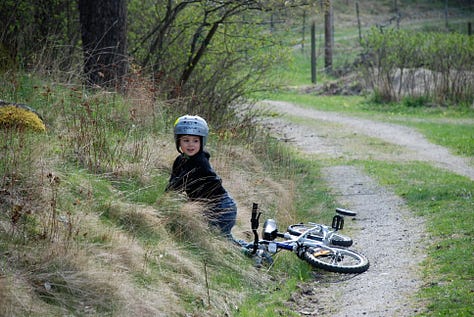
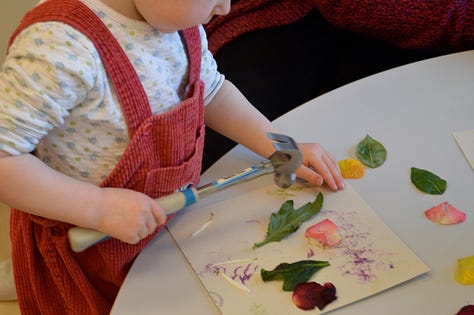
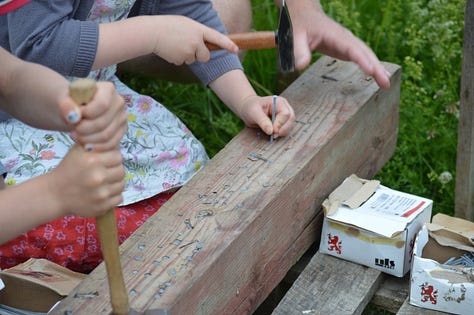
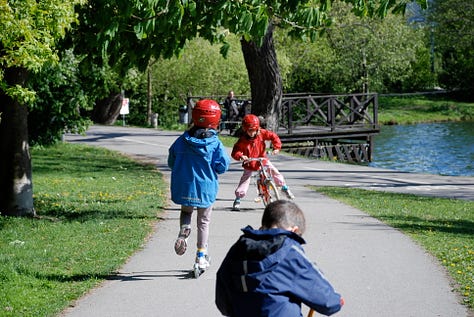


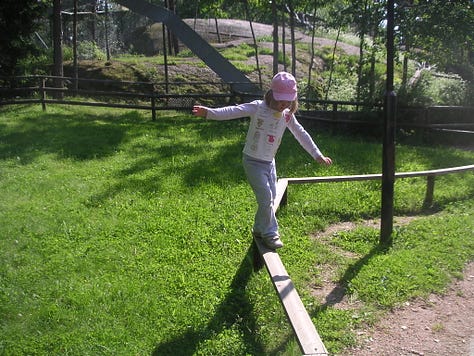
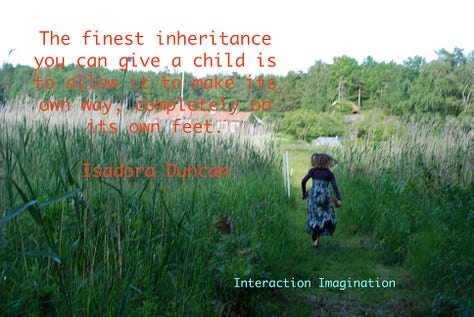
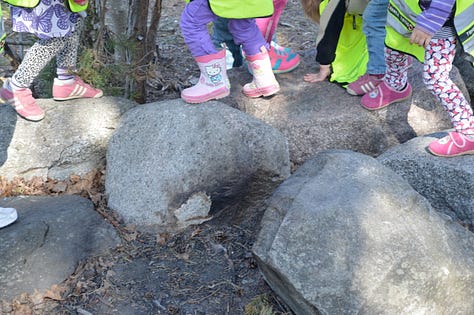
and yes, learning to ride a bike next to a lake has resulted in biking into said lake - which turned out to be a steep learning curve that one needs to focus on where you are going and not where you don’t want to be… (luckily we live close to the lake and could get into dry clothes again)




I love this so much!!!
Bruises and grazes from nature are learning marks.
Often, adults say to a crying child with a scraped knee, It's okay.You're fine." But I think it's an accumulated learning experience FROM THE CHILD to learn that it's okay and they're fine.
I also think not just their thoughts learn for the next time but their bodies also learn!
Moreover, it is a great natural opportunity to learn how to tend to our bodies, how to take care of others, and how to wait :)
Hi Suzanne, I was out in the forest with kids today, and as they were running down a steep slippery hill, I shouted in a sing-song voice, "If you run, you may fall." I use that phrasing often and am not sure how I feel about using it. What do you think about that phrase?